Chapter 19
Case Study: The Euro Disneyland Project
Project sponsors need to address two basic questions early in the planning stages for a project:
The Euro Disneyland Case Study illustrates how one major corporation addressed these issues, how financially restructuring a project can reallocate risk to other project participants and away from the original sponsor, and how the sponsor can derive benefits from this risk reallocation.
Introduction
Euro Disneyland would introduce to Europe a theme park and resort concept that The Walt Disney Company (“Disney”) had developed—and seemingly perfected—in the United States and Japan over the preceding 35 years. The first phase of the project (the “Euro Disneyland Project”) has been completed; other stages were scheduled to be completed later.
The complex financing structure Disney devised for the Euro Disneyland Project ultimately proved to be too highly leveraged. The high leverage created significant financial risk for a company that turned out to have relatively high operating risk. The financial success of the project depended importantly on the project entity's ability to develop and sell substantial real estate holdings at a significant profit in order to generate cash to pay down debt to a sustainable level. However, the real estate boom in France ended abruptly—principally because of a severe recession in Europe and an increase in interest rates.
At the time the project financing was arranged, it was viewed very favorably. One article assessing Disney's arrangement with the French government concluded that the Euro Disneyland Project will be “profitable. And ... the wealth will be shared.”1 A second article praised the structure and indicated that Disney had applied all the lessons it had learned from its other three theme parks in California, Florida, and Tokyo.2 In 1989, it seemed that Disney was well on its way to a huge success.
Project Description
Disney planned to build the theme park and resort on approximately 4,800 acres of land located 32 kilometers due east of Paris. Disney chose this site based on availability, communications, and proximity to potential customers, after considering more than 200 possible sites in France and Spain. Approximately 17 million people lived within a two-hour drive. More than 100 million lived within a six-hour drive. About half of the developable land, 2,115 acres, would be devoted to entertainment and resort facilities. Another 1,994 acres would be set aside for retail, commercial, industrial, and residential purposes. The balance of 691 acres would be used for regional and primary infrastructure, such as roads and railway tracks.
Upon completion, Euro Disneyland would be the largest theme park and resort development in Europe. It would be ideally situated at the hub of a vast transportation network. Euro Disneyland would be linked to Paris by the RER (regional express metro) suburban railroad system. It would be linked to the rest of France and Europe by the A4 motorway, and, in June 1994, by the high-speed train à grande vitesse (TGV) railroad network.
The project would feature two separate theme parks. It would be built in phases. Phase I would include the Magic Kingdom theme park, which would be modeled after similar theme parks in the United States and Japan; six hotels; an entertainment center; the Davy Crockett Campground; and related infrastructure and amenities. Phase IA would consist of the initial investment in the Magic Kingdom theme park, the Magic Kingdom Hotel, and peripheral development. Disney planned to complete Phase IA and open the Magic Kingdom in April 1992. Disney expected Phase IA to cost FF14 billion.3 Phase II would include a second theme park, the Disney MGM Studios Europe, based on Disney's MGM Studios theme park in Florida; additional hotel development; a water recreation facility; offices; and industrial, retail, and residential developments.
Disney planned to build a comprehensive resort facility containing more than 20 hotels (with 18,200 rooms). It would have six hotels (with 5,200 rooms) ready by 1992 when the Magic Kingdom would open. The other hotels would be added over a 20-year period. The resort facility would eventually include two golf courses, a water recreation area, campgrounds with 2,100 sites, and a large retail and entertainment complex. Disney's plans also included commercial development consisting of single- and multi-family residences, time-share apartments, more than 7.5 million square feet of office space, more than 8 million square feet of industrial space, and more than 1 million square feet of retail space.
Disney
Disney is a diversified entertainment company with headquarters in Burbank, California. Disney's operations fall into three principal segments: (1) the theme parks and resorts segment generated roughly 40 percent of the $8.5 billion in total revenue and 43 percent of the $1.7 billion in total operating income around the time Euro Disneyland opened; (2) the filmed entertainment segment accounted for 43 percent of revenues and 36 percent of operating income, and (3) the consumer products segment accounted for the remaining 17 percent of revenues and 21 percent of operating income. Disney is acknowledged as the world's leading theme park operator.
In the 1980s, Disney management had set a 20 percent growth target for the company. Expansion of theme park operations was an integral part of the strategy Disney had implemented to achieve that goal. With a well-penetrated American market, Disney realized that international expansion was necessary to achieve the growth target. The first international expansion took place in Asia; the Tokyo Disneyland theme park opened in 1983. The project was successful from the outset. This success prompted Disney to investigate other opportunities for international expansion. With the European Union taking shape, Europe seemed like an ideal site.
Project Ownership Structure
The original plan called for Disney to build, own, and operate the Euro Disneyland Project in a manner similar to its operation of Walt Disney World (Disney's Florida theme park) and Disneyland in Southern California. This ownership arrangement would ensure Disney 100 percent of the future earnings potential of the park. Disney management was determined not to repeat two mistakes of years past: (1) letting others build the lucrative hotels near the park, as happened at Disneyland in Southern California, and (2) allowing another company to own a Disney theme park, as occurred in Tokyo (where Disney only collects royalties from the immensely profitable attraction). Although the ownership structure would enable Disney to retain 100 percent of the upside potential, it would also leave Disney with 100 percent of the risks inherent in such a tremendous financial undertaking. Disney's then-current management had transformed Disney from a company with $1 billion of revenues into one with annual revenues of $3.4 billion (in 1988), mainly through internal growth. The corporate managers felt they could find a more advantageous way to structure the project.
Financial projections indicated expected profitability from the first year of operations (1992) amounting to approximately FF204 million on theme park revenues of FF4.25 billion and total revenues of FF5.48 billion.4 Net income was expected to reach FF972 million on total revenues of FF10.93 billion in 1995. For the year 2001, Disney projected total revenues of FF22.43 billion and net profit of FF1.76 billion. With such impressive profit expectations, it seemed inconceivable that Disney would want to bring additional participants into the project. However, under the agreement Disney negotiated with the French government—the Agreement on the Creation and the Operation of Euro Disneyland en France (the “Master Agreement”)—Disney was required to sell a majority stake in the project entity to European investors in order to “share the wealth.”
In the spring of 1989, Disney set in motion a series of transactions that altered the ownership, management, financing, and control of the Euro Disneyland Project. Figure 19.1 illustrates the resulting ownership structure. Disney reduced its 100 percent equity interest in the project to 49 percent. The transactions initiated in the spring of 1989 would also reimburse Disney for FF1.9 billion of project development costs, increase the project's leverage substantially, and result in the public offering of common stock by a company that had never earned any revenues. The change in project structure was made in part in response to the French government's request, but limiting the risk exposure of Disney's shareholders was undoubtedly another important consideration.
Figure 19.1 Ownership Structure for the Euro Disneyland Project
Source: Euro Disneyland S.C.A., Offer for Sale of 10,691,000 Shares (October 5, 1989), p. 53, and Bruner and Langohr (1994), p. 742.
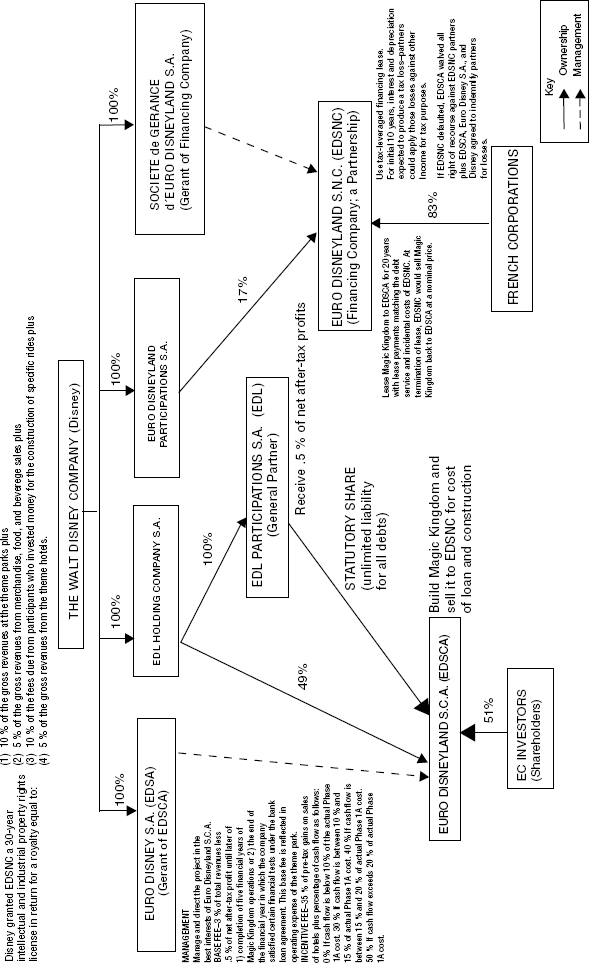
Project Entities
The primary participants alongside Disney included a bank consortium (consisting of about 60 banks), the French government, other creditors, and public shareholders. Ownership, however, was limited to two French “owner companies” provided for in the Master Agreement.
Master Agreement with the French Government
The French government played a significant role in Euro Disneyland's development. Disney and the French government signed the Master Agreement in February 1988. The French government agreed to:
 Provide 1,665 hectares of land for the theme park resort and for commercial and residential development. The land would be sold to Euro Disneyland at a fixed price based on (1) the price of raw agricultural land in 1971, or approximately FF111,000 per hectare, plus (2) the cost of direct and indirect infrastructure (other than roads and railways) and (3) certain overhead charges.6 At the time, raw land zoned for commercial uses in the Île-de-France region was selling at prices ranging from FF170,000 to FF210,000 per hectare (see Bruner and Langohr, 1994, p. 737). EDSCA would have 20 years to complete the land purchases at the quoted fixed price.
Provide 1,665 hectares of land for the theme park resort and for commercial and residential development. The land would be sold to Euro Disneyland at a fixed price based on (1) the price of raw agricultural land in 1971, or approximately FF111,000 per hectare, plus (2) the cost of direct and indirect infrastructure (other than roads and railways) and (3) certain overhead charges.6 At the time, raw land zoned for commercial uses in the Île-de-France region was selling at prices ranging from FF170,000 to FF210,000 per hectare (see Bruner and Langohr, 1994, p. 737). EDSCA would have 20 years to complete the land purchases at the quoted fixed price. Finance, construct, and operate a 20-km extension of the Paris suburban railroad. The extension would provide direct access to the gates of the Magic Kingdom from central Paris. As part of the extension, the French government would build two railroad stations, a car park, and a bus station.
Finance, construct, and operate a 20-km extension of the Paris suburban railroad. The extension would provide direct access to the gates of the Magic Kingdom from central Paris. As part of the extension, the French government would build two railroad stations, a car park, and a bus station. Finance and construct two junctions to link a major highway, the A4 motorway, with Euro Disneyland.
Finance and construct two junctions to link a major highway, the A4 motorway, with Euro Disneyland. Contribute FF200 million, which would cover part of the cost of constructing secondary roads.
Contribute FF200 million, which would cover part of the cost of constructing secondary roads. Provide up to FF4.8 billion in loans at a fixed annual rate of 7.85 percent.7 The loans would mature in 20 years with amortization beginning in the sixth year.
Provide up to FF4.8 billion in loans at a fixed annual rate of 7.85 percent.7 The loans would mature in 20 years with amortization beginning in the sixth year. Apply the lowest rate of value added tax (VAT), 5.5 percent, to all consumer products sold at Euro Disneyland.8
Apply the lowest rate of value added tax (VAT), 5.5 percent, to all consumer products sold at Euro Disneyland.8In addition to the undertakings contained in the Master Agreement, the French government agreed to:
 Provide high-speed TGV train service to Euro Disneyland starting in June 1994.
Provide high-speed TGV train service to Euro Disneyland starting in June 1994. Allow EDSNC to depreciate Magic Kingdom assets over a 10-year period, rather than the usual 20-year period.
Allow EDSNC to depreciate Magic Kingdom assets over a 10-year period, rather than the usual 20-year period.Analysts estimated that the entire package of concessions from the French government was worth between FF3.3 billion and FF6 billion, or roughly the equivalent of $54,000 to $98,000 for each new job the project would create (see Bruner and Langohr, 1994, p. 737).
In signing the Master Agreement, Disney agreed on behalf of EDSCA and EDSNC to:
 Open the Magic Kingdom by April 1992.
Open the Magic Kingdom by April 1992. Guarantee a minimum of 9.13 million one-way journeys each year on the suburban rail system, for a period of five years after opening.9
Guarantee a minimum of 9.13 million one-way journeys each year on the suburban rail system, for a period of five years after opening.9 Pay FF45 million for utility and electrical networks.
Pay FF45 million for utility and electrical networks. Guarantee a minimum amount of tax revenue to Seine-et-Marne.10
Guarantee a minimum amount of tax revenue to Seine-et-Marne.10 Encourage share ownership in EDSCA by European Economic Community nationals.
Encourage share ownership in EDSCA by European Economic Community nationals. Use French and other European Economic Community contractors and suppliers.
Use French and other European Economic Community contractors and suppliers. Include at least one attraction in the Magic Kingdom depicting French and European civilization.
Include at least one attraction in the Magic Kingdom depicting French and European civilization. Refrain from opening or licensing another theme park within 800 km of Euro Disneyland for five years after opening the Magic Kingdom.
Refrain from opening or licensing another theme park within 800 km of Euro Disneyland for five years after opening the Magic Kingdom. Hold at least 17 percent of the shares of EDSCA and EDSNC until the fifth anniversary of opening day.
Hold at least 17 percent of the shares of EDSCA and EDSNC until the fifth anniversary of opening day.Project Financing
The project financing transactions initiated in the spring of 1989 transformed the Euro Disneyland Project from an internally financed and privately owned project to a highly leveraged and publicly owned entity in which Disney would hold a minority interest. However, although Disney would hold only a minority interest in the equity of the project, it would still control the construction and operation of the theme park and would have the right to own and control the development of the hotels and other real estate.
The project financing would introduce many additional stakeholders into the Euro Disneyland Project through a two-stage process. The first stage would involve a private placement of common shares and debt securities called Obligations Remboursables en Actions (ORAs) to four investor banks and EDL Holding. EDL Holding would serve as the shareholder of record for Disney's 49 percent stake in the new company. The second stage of this process involved EDSCA's initial public offering (IPO). The IPO would result in 50.5 percent of the shares being sold to the investing public. (The remaining 0.5 percent would be retained by the original four investor banks, as discussed below.)
Phase IA of the Euro Disneyland Project initially had a projected capital cost of FF14 billion. The projected sources of these funds, in millions of French francs, are shown in the following summary:

The equity portion of the project financing would take place in two stages, as reflected in Table 19.1.
Table 19.1 Pro Forma Balance Sheet of EDSCA as of September 30, 1989 (Thousands of French Francs).
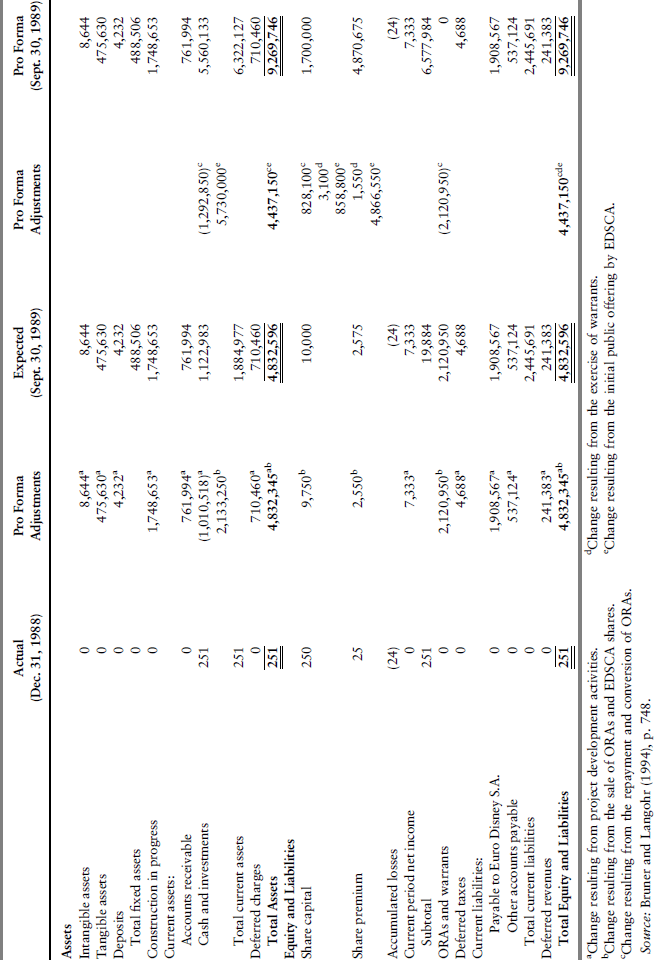
Disney's net cash investment in EDSCA would be approximately FF833 million, consisting of: (1) FF250,000 for 25,000 shares in 1985; (2) FF4,650,000 for 465,000 shares in March 1989; and (3) FF828.1 million for the ORAs, also in March 1989. After the IPO, EDSCA's total assets would be FF9.3 billion.
Leverage
Based on the pro forma financial statements presented in Table 19.1, the expected total assets of EDSCA at September 30, 1989, would amount to FF4,832,596,000. Liabilities and shareholders' equity would consist of FF2,691,762,000 of liabilities and FF2,140,834,000 of equity. This debt–equity mix would imply a debt-to-equity ratio of 126 percent. Assuming the exercise of the outstanding options and warrants and a successful IPO by EDSCA, equity would increase to FF6,577,984,000. This increase in equity would reduce the debt-to-equity ratio to approximately 41 percent. However, Disney projected that the debt-to-equity ratio would subsequently increase to approximately 200 percent by 1994, just prior to completion of Phase 1A of the Euro Disneyland Project. EDSCA felt it could justify this level of debt based on its expectation that it would be able to develop the hotel real estate, sell it at a substantial profit, and use the proceeds to pay down debt. However, as we now know, this strategy was not successful because of the collapse in the real estate market, and the degree of leverage proved to be excessive.
The Initial Public Offering
In the fall of 1989, EDSCA went public in one of the largest IPOs of common stock by a company that had no operating history. The shares were offered at FF72 each (£7.07 each in the United Kingdom). The expected net proceeds of FF5.73 billion were to be used to repay debt—including the ORAs held by the investor banks and FF1.9 billion of project development loans extended by Disney prior to the offering—as well as to fund construction costs. The offering was successful. Approximately 85.9 million shares were offered. Within three days, total demand reached 10 times that amount. Shares were listed for public trading on the Brussels, London, and Paris stock exchanges.
Projected Returns to Disney
In spite of Disney's giving up 51 percent of the equity ownership in the project, the net present value (NPV) of the project with respect to Disney would remain essentially the same. Tables 19.2 and 19.3 indicate, respectively, the expected cash flows to Disney under two alternative assumptions: (1) the Euro Disneyland Project is financed on a stand-alone basis, and (2) it is financed as a fully integrated internal project. These projections are based on the information contained in the October 5, 1989, offering circular for EDSCA's IPO.
Table 19.2 Projected Cash Flows to Disney, Assuming the Euro Disneyland Project Is Financed on a Project Basis (Millions of French Francs).
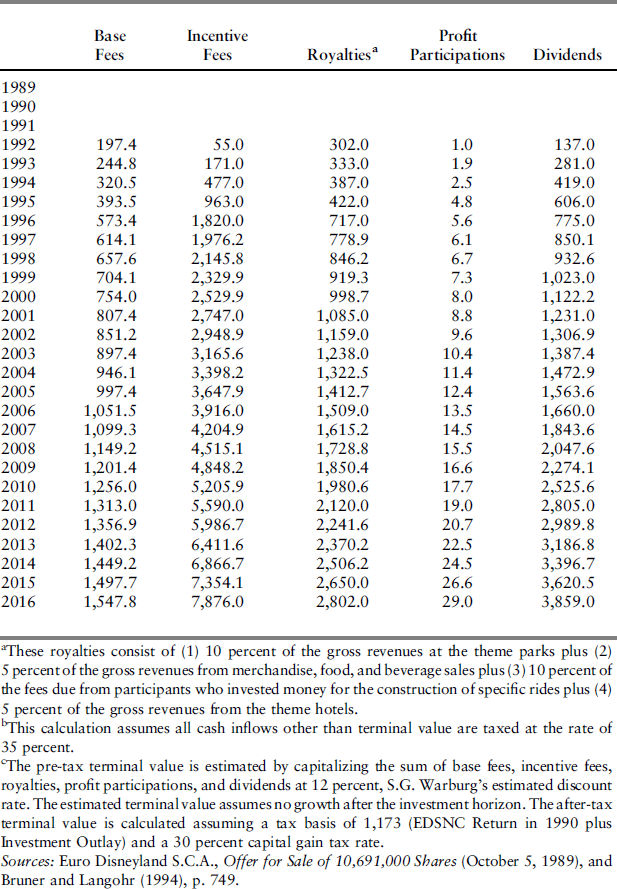
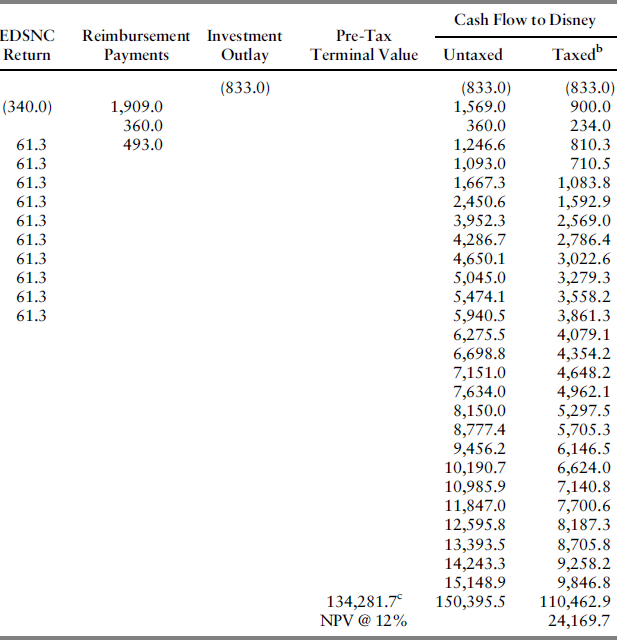
Table 19.3 Projected Cash Flows to Disney, Assuming the Euro Disneyland Project Is Financed as a Fully Integrated Internal Project (Millions of French Francs).
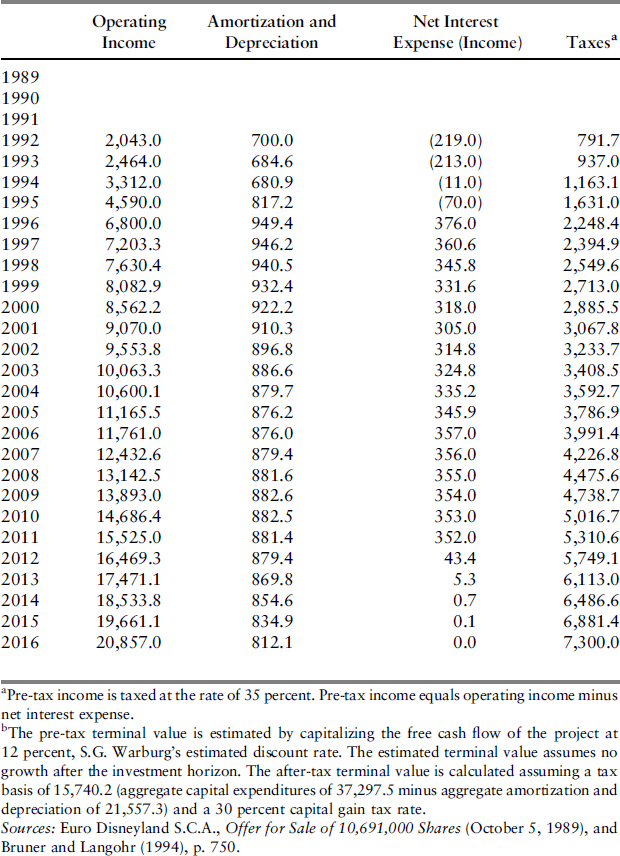
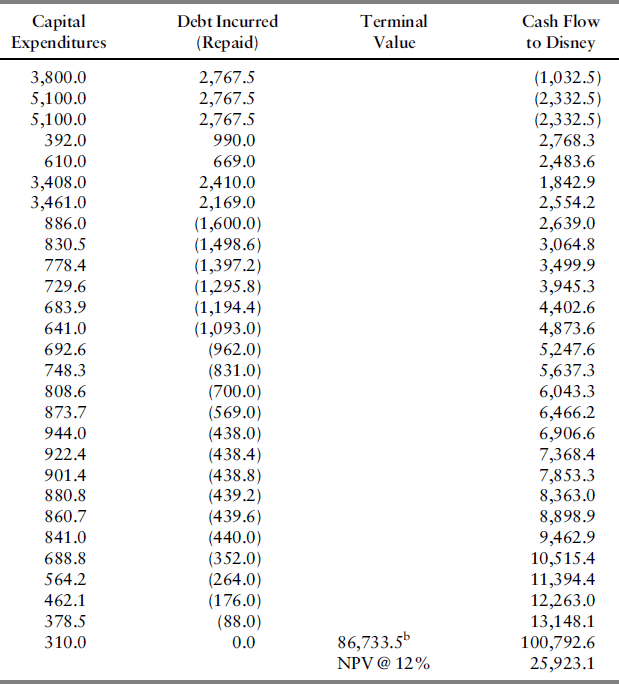
The net present value of the project to Disney, at a 12 percent discount rate, would be FF25,923.1 million if the project was a fully integrated internal project. It would be FF24,169.7 million if the project was financed as proposed. The difference is only FF1,753.4 million, or roughly 6.8 percent of the net present value if the project were fully integrated. Consequently, by adopting the project financing structure, Disney decreased its equity ownership by 51 percent but reduced its expected net present value by only approximately 6.8 percent. Disney substantially reduced its risk exposure without giving up much profit potential. Disney would obtain significant financial benefits in the form of management fees, incentive fees, and royalties. These payments would seemingly guarantee Disney a significant return even if the project was only marginally successful.
Interests of the Participants in the Project
A project financing will be successful only if it satisfies a community of interests. All the parties must determine that the benefits from participating outweigh the costs. To be successful, a project financing must allocate the rewards from the project in a manner that is commensurate with the allocation of project risks.
Disney Considerations
Disney significantly reduced its financial risk exposure while preserving the opportunity to earn an attractive rate of return. Disney negotiated extremely favorable management, licensing, incentive, and merchandising fees. EDSCA paid Disney approximately FF330 million in fiscal 1992 and approximately FF482 million in 1993. Without these costs, EDSCA would have made a small profit in 1992.
The French government offered Disney various concessions worth roughly FF6.0 billion. Disney recovered FF1.9 billion of the development costs of the Euro Disneyland Project and monetized its remaining ownership interest through the public offering. After the IPO, Disney owned 49 percent of EDSCA, for which it had contributed only 13 percent of EDSCA's book value. Moreover, it controlled the management of the project through its 100 percent ownership of the project gérant.
French Government Considerations
Several factors motivated the French government. Unemployment in the region near the park was high. Construction of the park would create approximately 30,000 jobs. The French government also stood to benefit from a new source of tax revenue. In the first year alone, if the expected 11 million visitors spent only the $40 entrance fee, the government would realize $440 million of tax revenue. Increased revenues would also be generated from utility and electric networks, as well as from suburban rail systems. The French government estimated that foreign tourists would spend $1 billion in the local economy, and it hoped that France would become the capital of the European tourist industry.
Thus, Euro Disneyland would (1) provide a substantial number of jobs to local residents, (2) inject a substantial amount of money into the local economy during construction of the facility, (3) attract to the area a large number of visitors whose spending would stimulate the local economy, (4) have a favorable effect on land values in the area, and (5) allow French and other European investors to share in the wealth the Euro Disneyland Project was expected to create.
European Creditor Bank Considerations
A consortium of about 60 banks eagerly agreed to provide the construction loans. These loans were all nonrecourse to Disney. Motivated by an opportunity to earn fees and interest income and hold an equity stake, and perhaps charmed by the Disney name, the banks were quite willing to extend credit. The banks, however, had much at risk. In the event of default, the assets that served as collateral might prove difficult to liquidate. The assets of the park consisted of the land, exhibits, and rides, none of which could be disposed of easily. Other lenders had hotels collateralizing their loans. Soon after the loans were extended, real estate values became severely depressed, making liquidation difficult. Also, what value would the hotels have if the theme park were forced to close?
The banks undoubtedly took comfort from Disney's overall management of the Euro Disneyland Project. Disney would have enormous reputational capital at stake. A failure of the project could have serious implications for future Disney theme park and resort projects.
European Equity Investors' Considerations
The European equity investors contributed a substantial amount of cash in exchange for a 51 percent equity interest. Of the total equity of FF6,570,675,000 as of September 30, 1989, Disney contributed approximately FF833,000,000, or approximately 12.67 percent of the capital, for 49 percent of the equity. The European investors invested approximately FF5,737,675,000, or approximately 87.33 percent of the capital, for 51 percent of the equity. Accordingly, the European investors were substantially diluted from the outset. It appears that the European equity investors were enticed by the prior success of Disney; they anticipated that this success would easily transfer to the Euro Disneyland Project. As evidenced by the heavy demand for the shares of EDSCA at the initial offering price of FF72, European investors welcomed the opportunity to invest alongside Disney.
Financial Projections
EDSCA published detailed financial projections in the offering circular for its initial public offering. Table 19.4 presents income projections and projected total returns to the equity investors, by year, for the period 1992–1996 and at five-year intervals thereafter through 2016. Table 19.5 provides cash flow projections for EDSCA for the same years.
Table 19.4 Profit Projections for EDSCA (Millions of French Francs).
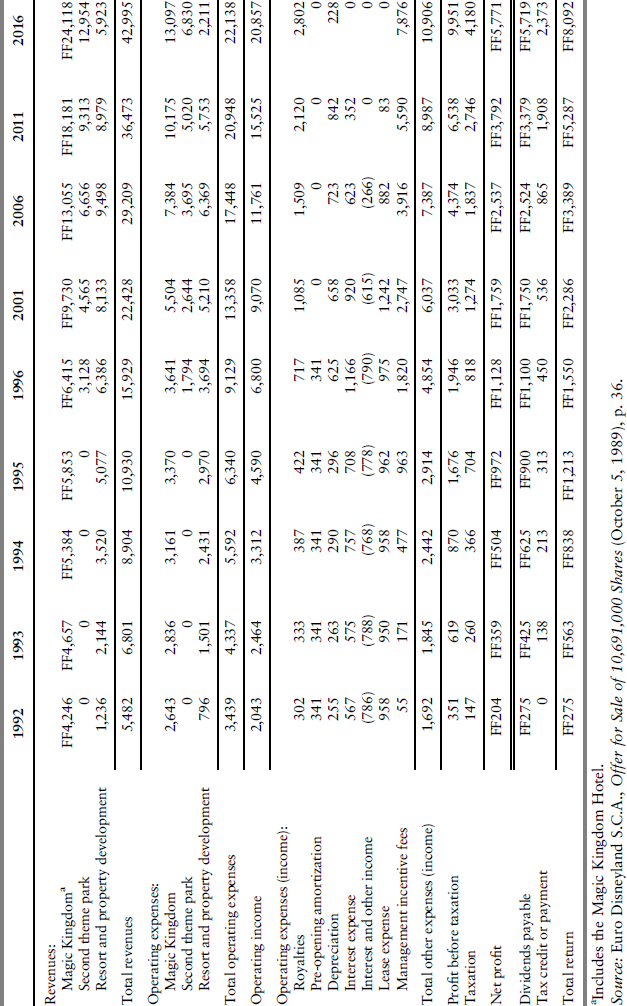
Table 19.5 Cash Flow Projections for EDSCA (Millions of French Francs).
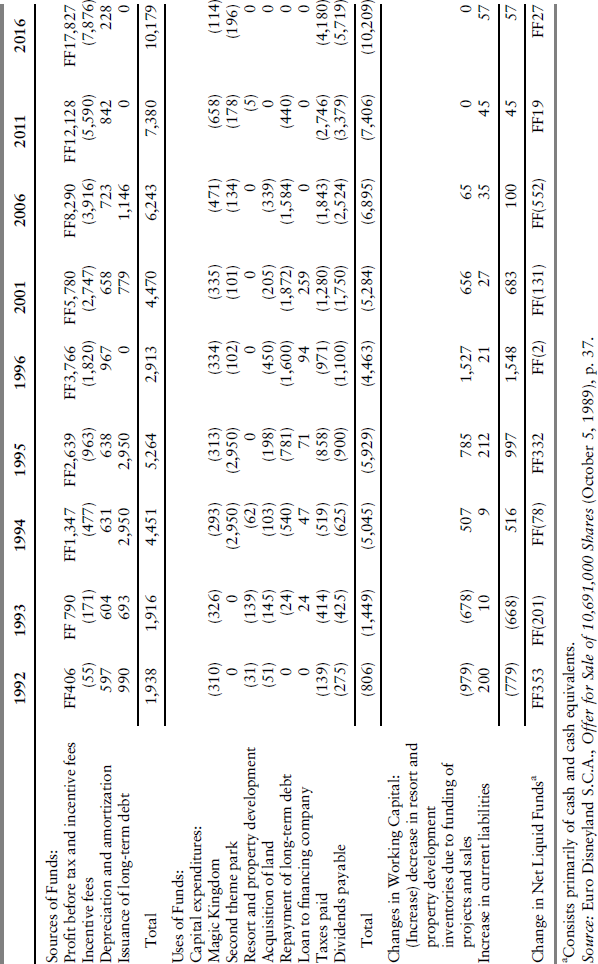
Valuation
In a traditional spin-off, equity carve-out, or IPO of a previously privately held company, the investment banker usually has the luxury of having historical operating results on which to base future projections and prepare a valuation. Historical industry patterns can be evaluated, and the company being valued can be compared to comparable companies. In addition, the company's management team may be staying on, adding an important intangible value. The company's business plan can then be realistically evaluated. However, even with an abundance of historical information, assessing the value of an IPO entails making an educated guess. The valuation of EDSCA posed an even greater challenge: It was not a going concern at the time of its IPO. Nevertheless, based on its analysis of Disney's projections, the British investment bank S.G. Warburg concluded that EDSCA's shares were worth approximately FF70 each.
Discount Rate
The first challenge Warburg faced was estimation of the appropriate discount rate to use in its discounted cash flow analysis. Warburg concluded that there were no publicly traded companies that were directly comparable to EDSCA. However, it identified two French companies that had somewhat similar risk profiles (albeit significant differences).
The first company was Club Mediteranée, which had a globally diversified destination resort portfolio. In contrast, Euro Disneyland had only one theme park. Club Med diversified its risk through its global portfolio; if weather or political problems persist at any one resort, tourists can be accommodated at other locations. Additionally, Club Med's destination options encourage repeat visits, whereas one may not be inclined to visit the same resort twice.
The second company was Accor, the leading French hotel operator. Again, similarities existed but the differences were great. Accor's hotels were dispersed over a large geographic area, thus limiting the company's exposure to difficulty in any one area. Also, the value of Euro Disneyland's hotels would undoubtedly fall significantly if the theme park performed poorly.
Warburg believed that equity investors would require a 20 percent rate of return prior to opening (October 1989 to April 1992), to reflect the riskiness of the project (in particular, the fact that it was not a going concern), and a 12 percent rate of return after opening. The 12 percent discount rate was derived by analyzing the cost of capital for Disney, Accor, and Club Med. These companies had costs of capital of 9, 11.3, and 11.9 percent, respectively. The 12 percent discount rate was only marginally higher than the required rates of return for Accor and Club Med. Consequently, this discount rate did not seem to give adequate consideration to the risk differential between the established operations of the comparable companies and the start-up nature of EDSCA. It would seem appropriate to have included a higher risk premium in valuing the shares of EDSCA, in order to take into consideration that the theme park had not been constructed and would not be in operation for several more years. Also, Warburg evaluated the dependence on the sale of real estate as a low-risk proposition. A more appropriate discount rate would have been several percentage points higher to compensate for the added risk.
In addition, it is not clear that Warburg adequately considered the proposed capital structure in determining the discount rate of 12 percent. The debt-to-equity ratio of EDSCA at the time of the offering was only 40 percent. However, it was expected to increase to over 200 percent by 1995. This high degree of leverage would substantially increase the financial risk associated with EDSCA's shares, as compared to the other companies. It does not seem that this level of financial risk was appropriately reflected in the 12 percent discount rate Warburg used.
Estimated Attendance at Euro Disneyland
It was generally assumed in 1989 that two factors would be critical to the success of the Euro Disneyland Project: (1) attendance at the theme park and its related facilities and (2) the development of the real estate. It was felt that attendance at the theme park would be an important factor in its success, but that the number of guests visiting the park each year would exceed expectations. The projections Disney prepared assumed 11 million visitors in the first year. This figure was generally considered conservative. An analysis prepared by Arthur D. Little, a consulting firm, projected a minimum attendance of 11.7 million in the first year and suggested a possibility of up to 17.8 million admissions.11 One article noted that Disney conservatively estimated first-year attendance at 11 million and remarked that Disney was notorious for understating attendance estimates.12
Forecasted Prices
Disney also assumed that certain revenue-generating items, such as ticket prices, hotel and campsite rates, and lease rates, would increase at a rate 1.5 percent greater than the rate of general price inflation in France. In the United States, Disney's ticket prices had grown at a real rate of 2.6 percent per annum over the preceding 17 years. Therefore, it did not seem unrealistic to expect that prices could rise faster than inflation without causing a dramatic decrease in park attendance, hotel reservations, or commercial leasing within the complex.
Results
Investors seemed to believe that if the theme park could meet its target of 11 million visitors the first year, EDSCA would be profitable. The target was met, but Euro Disneyland's performance fell well short of expectations. Disney and its advisers failed to see the signs of the approaching European recession, which resulted in lower per-capita spending. Hotel occupancy rates were below expectations. Moreover, guests were not staying as long or spending as much as expected on the high-priced food and merchandise. The depressed real estate market also made hotel sales unlikely; the capital gains from hotel sales were projected to be an important source of returns from the Euro Disneyland Project.
Seasonality
Both Disneyland (California) and Walt Disney World (Florida) are in locations with warm climates, where year-round operation of all rides and attractions is feasible. Thus, fairly strong year-round attendance is a realistic expectation. This was unlikely to be the case in France, where the weather is not warm and pleasant year-round. (In the sensitivity analysis discussed below, Warburg tested the attendance assumption by using a reduced attendance forecast of 10 million the first year. This reduction began to affect dividends adversely by 2001.)
Other Shortcomings
Additional assumptions regarding European habits proved to be inaccurate. For example, EDSCA assumed that Europeans do not eat breakfast. Much to EDSCA's surprise, more than 2,000 visitors began showing up for breakfast in a hotel restaurant designed to accommodate 300. EDSCA executives also believed that they could change European habits, such as a reluctance to pull their children from school in midsession as American parents do, or a preference for longer holidays rather than short breaks. Additional errors made things worse. An insufficient number of rest rooms for bus drivers and a policy of serving no alcohol in the theme park, in a country where a glass of wine with lunch is standard, are just two examples.
Real Estate Ownership and Development
Based on its experience in California and Florida, Disney believed it was essential to control the land and hotels around the Euro Disneyland Project. In California, the original Disney park had been enormously successful. However, Disney did not own any land. It therefore could not expand the facility or offer ancillary services, such as hotels. The restricted acreage was quickly surrounded by hoteliers and fast-food outlets that took advantage of the millions of visitors each year. In Florida, however, Disney owned sufficient land but did not build enough of its own hotel rooms. Disney built hotels with 7,000 rooms and then watched the total number of hotel rooms in the area grow from 4,000 in 1971 to over 70,000 in 1989. These Florida hotels had averaged 92 percent occupancy with an average room rate of $166 per night.13 In addition, it was estimated that visitors tended to stay an extra day at the Disney hotels, which resulted in more hotel revenue and an additional estimated $90 per day spent on food and merchandise per person.
The value of property around the theme parks also increased significantly. In California, land values had increased by 20 percent per year for 25 years.14 In Florida, they had increased by 30 percent per year.15 In establishing the Euro Disneyland Project, Disney wanted to ensure that it would have control over land and real estate development in order to capture these economic benefits. But the financial success of the Euro Disneyland Project would depend on the ability of EDSCA to develop the resort property and sell the developed properties quickly at substantial profits.
Real Estate Projections
The projections Disney prepared were based on very favorable assumptions regarding the development and sale of real estate. For example, through 1995, over 74 percent of each year's projected pre-tax income would result from real estate development activities (see Table 19.4).16 If the real estate development activities in the years 1992 through 1995 did not perform as planned, EDSCA could suffer a substantial cash shortage. This is indeed what happened.
Dividend Projections
EDSCA's dividend policy required a payout that was substantially equal to net income each year through 1995. This dividend policy increased EDSCA's borrowing requirements. (The net change in debt in each of those years exceeded the dividend amount.) Consequently, EDSCA's dividend policy would be funded through borrowing, with the expectation that future cash flows would be sufficient both to maintain that dividend policy and to pay off the debt.
Sensitivity Analysis
Warburg conducted a sensitivity analysis on returns to investors, based on key assumptions provided by Disney. Table 19.6 contains the results of the sensitivity analysis. Although the analysis demonstrated the effect on the internal rate of return of 10 percent swings in key value drivers through 2017, the base assumptions appear to have been overly optimistic to begin with. Warburg could have taken this into account by increasing the sensitivity ranges for the key value drivers from the 10 percent level to 15 percent or even 20 percent. The most sensitive value driver was reduced per-capita spending. In addition, Warburg varied only one variable at a time. Sensitivity analyses often include a “worst case scenario” in which several variables experience a 10 percent (or greater) change.
Table 19.6 Sensitivity Analysis.
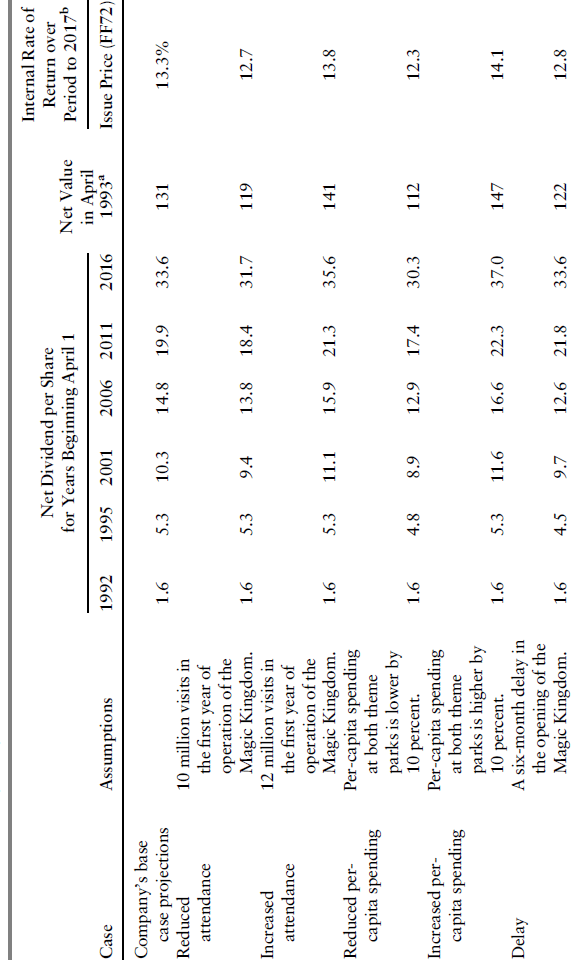
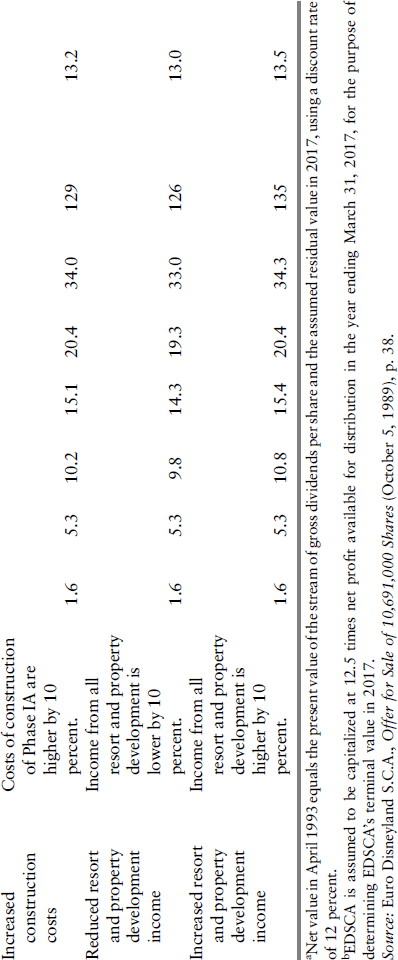
Overoptimism?
The valuation of EDSCA at FF72 per share now appears to have been overly generous. It was subsequently revealed that “Several European financial institutions, including Lazard Frères—Disney's own advisor—worried that the plan was too clever.... The company was overleveraged. The public offering price seemed high, and the proposed financing appeared risky because it relied on capital gains from future real estate transactions.”17 As noted, the project encountered difficulty for several reasons: (1) interest rates started to rise by the time EDSCA began to borrow heavily; (2) a prolonged recession began in Europe; (3) the real estate market in France became severely depressed; and (4) EDSCA's operating results were disappointing, particularly for the hotels.
It is easy to look back with the benefit of hindsight and criticize Warburg's valuation of the EDSCA shares. European investors, however, perceived the shares as fairly valued. Following the offering in 1989, and continuing through the opening of the park in 1992, EDSCA's shares traded at a premium; some investors paid as much as FF160 a share. It was not until losses started to accumulate that the market value of EDSCA's shares began to decline.
Corporate Governance Issues
The organizational structure of EDSCA further complicated the situation. Disney placed its top management at EDSA, the management company, and not at EDSCA. Their incentive bonuses, through stock options, were issued in shares of Disney stock. However, the interests of EDSCA's shareholders and Disney's shareholders could be diametrically opposed. Options should have been based on the EDSCA share price, for a better alignment of management incentives and shareholder interests. Additionally, there was the potential for managerial gridlock to develop. The Disney-controlled management companies were responsible for the operation of the theme park. The supervisory board oversaw and approved all contracts entered into by the gérant. However, the supervisory board lacked the authority to make the gérant take action and also lacked the power to remove the gérant. The supervisory board could refuse to approve contracts if it objected to the gérant's actions. That response could potentially immobilize the company.
Operating Results
Euro Disneyland opened on schedule on April 15, 1992. However, it became apparent within two months of the opening that the Magic Kingdom was not attracting visitors at the rate initially expected. Farmers and truckers blocked roads leading to the park in the summer of 1992, to express grievances unrelated to Euro Disneyland. Attendance suffered.
In its first year of operations, EDSCA reported revenues of $738 million and a net loss of $135 million. Fiscal 1993's performance was worse. EDSCA reported revenues of $873 million and a net loss of $1.1 billion (or $528 million before the cumulative effect of accounting changes). For the fiscal year ended September 30, 1993, EDSCA reported a loss of FF5.337 billion (equivalent to approximately $920 million), one of the largest losses in French corporate history.
The development and operation of the hotels and other resort property produced results significantly below projections. The cash flow realized from the sale of real estate was also well below projections. Because the success of the Euro Disneyland Project depended strongly on the cash flows from the real estate activity to pay down EDSCA's debt, a severe cash shortage developed. Until a restructuring was completed, it was unclear whether EDSCA could continue as a going concern.
In comparing the actual results with the projected results, the real estate activity appears to be the most disappointing. At the time of the IPO, EDSCA estimated that the occupancy of the hotels would run between 80 percent and 85 percent, as compared to 90 percent or better occupancy rates for the Disney hotels in Florida.18 However, Disney did not anticipate that visitors to Euro Disneyland would rather stay in Paris, just 35 miles from the theme park, either forsaking the park's hotels altogether or minimizing their stay. Compared to the original expectations, the actual occupancy rates were extremely disappointing, reportedly as low as 55 percent.19 The disappointing results for the hotels also contributed to Disney's inability to sell them at an acceptable price.
A second problem concerned the hotel room rates: They were too high for the market. For example, a room at the flagship Disneyland Hotel originally cost about FF2,000 (or $340) per night. This rate was approximately the same as the cost of a room at a top hotel in Paris. In an attempt to increase hotel occupancy, Disney substantially reduced room rates. For example, at the low-end hotels, such as the Sante Fe, rates were reduced from the equivalent of $76 per night to $51 per night, a reduction of over 32 percent.20 Similar reductions were made at the other hotels, including those at the high end. These rate reductions increased occupancy but resulted in hotel revenue falling well below projected amounts.
The Magic Kingdom was generally successful when considered by itself. The attendance estimates of 11 million were essentially reached in the first year. However, in order to reach this attendance level, EDSCA had to reduce ticket prices significantly.21 Cutting ticket prices for French citizens boosted attendance but took a big bite out of projected revenues. As many as 70 percent of winter visitors have been estimated to have taken the discount offered French citizens.22
In addition to problems with the real estate and resort property development, the estimated cost of the Euro Disneyland Project substantially exceeded estimates. Phase IA was expected to cost FF14 billion. It actually cost more than FF18 billion. As these additional costs were financed through added borrowing, EDSCA's financial problems were exacerbated. Eventually, EDSCA's total debt stood at nearly FF21 billion, or the equivalent of approximately $3.75 billion.23
Subsequent Developments
Disney tried to turn around the Euro Disneyland Project. At one point, it was on the verge of bankruptcy. On March 14, 1994, Disney, EDSCA, and a steering committee representing EDSCA's creditors announced a massive financial restructuring of EDSCA. Disney agreed to invest an additional $750 million as part of the restructuring plan. The plan, which was accepted by 61 of EDSCA's 63 banks, reduced EDSCA's debt from the equivalent of approximately $3.52 billion to approximately $1.73 billion. As part of the plan, Disney agreed to forfeit for five years the management fees and royalties from ticket and merchandise sales. These fees could not be collected at all if the theme park were forced to close. The plan also called for the bank consortium to forgive 18 months' interest payments, defer principal repayments for three years, and provide approximately $500 million of additional loans. The plan provided for a FF6 billion (equivalent to $1.07 billion) rights offering, in which Disney would subscribe for its 49 percent share at a cost of approximately $508 million. The creditor banks would underwrite the remaining 51 percent of the rights offering to the other shareholders.
The plan represented a mixed blessing for EDSCA's shareholders. The restructuring and rights offering would increase the likelihood of EDSCA's survival as a going concern. However, the offering would more than quadruple the number of shares outstanding, severely diluting nonsubscribing shareholders. Nevertheless, their shares might have become worthless if EDSCA had been forced into bankruptcy.
The rights offering was successful. Shareholders were allowed to subscribe for 7 new shares for every 2 shares held, creating 600 million new shares, at 10 francs per share. The offering was 80 percent subscribed by existing shareholders (including Disney, at 49 percent). The underwriting syndicate, led by Banque Nationale de Paris, Banque Indosuez, and Caisse des Depôts et Consignations, took up the unsubscribed shares. In conjunction with the rights offering, a wealthy Saudi investor agreed to invest up to $500 million for as much as 24 percent of EDSCA by purchasing any unsubscribed shares.24 This commitment sent a favorable signal to investors, which contributed to the success of the rights offering.
In 1999, EDSCA secured financing for the construction of Walt Disney Studios Park, an additional attraction in the style of Disney-MGM Studios in Florida. Another share capital increase of $230 million provided equity while an additional loan of approximately $400 million was obtained from the banking consortium. Unfortunately, these additional loans added to an already sizable debt burden directly before a period of relative stagnation for European tourism. Additional refinancing was required in 2005 to cover unsustainable debt obligations following several losses. This included a third share capital increase of about $340 million and a revolver loan provided by Disney directly.25
Disney also made another concession regarding its management fees and royalties. Unlike the 1994 restructuring, however, Disney did not simply allow for a forfeiture of the fees. In this case, an amount totaling about $270 million would be converted to subordinated debt through 2014 as long as EDSCA remained unable to meet certain financial benchmarks.26 As of September 2011, these standards had not been met for any fiscal year. Although Euro Disneyland remains by far the most visited theme park in Europe and although operating margins have remained positive the last few years, the large interest obligations led to net losses of $92 million, $62 million, and $86 million in 2009, 2010, and 2011, respectively.27
Conclusion
Euro Disneyland's performance would seem to suggest that Disney was unwise to attach its name to this project from its conception. This is a somewhat unfair assumption, however. The park may not be as busy as initially imagined, but it consistently draws an annual crowd that is almost three times as large as the second most popular themed attraction in Western Europe. Total attendance grew by about 21 percent between 2006 and 2011, and operating income remained positive through the financial crisis.28
Disney understood the risks involved in the project. By forming a separate company and arranging for outside equity investors, Disney believed it was limiting its risk exposure in the project while sacrificing only a relatively small percentage of its potential returns. On the contrary, Disney has had to make financial concessions numerous times since the park opened, including investing additional funds, extending loans, and deferring expected royalties. In late August 2012, news reports began circulating that Disney may be considering the possible takeover of EDSCA.29
This may prove to be the best possible option for Disney. The terms of the revolving loan and deferment allowances originally granted to EDSCA will expire soon. Without their renewal, EDSCA may face an unsustainable debt burden. Additionally, EDSCA will be required to pay off a large portion of its senior loans over the next decade. Given adequate operating profits and a recent spike in hotel occupancy, a move by Disney to take direct control could finally enable the theme park to achieve positive cash flow. Greater managerial efficiency, less reliance on outside financing, and the ability to invest directly in long-needed park infrastructure may outweigh the benefits of traditional project financing at this point in Euro Disneyland's life.